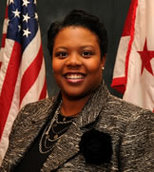Should all AP classes be in one DCPS building?

Photo by DCPS.
DC Schools Chancellor Kaya Henderson says she’d like to consolidate all AP classes in one building rather than “trying to get at least five AP classes into every single one of my 17 high schools.” Does that make sense?
In an interview with The Northwest Current that followed on the heels of her speech on the state of DCPS last week, Henderson went through a wish list of innovations she’d like to see at middle and high schools. Some of them sound appealing, but the AP idea was puzzling.
Henderson suggested that “kids could go take AP classes [at the designated AP school] from 2 p.m. to 8 p.m. every afternoon or all day Saturday.”
That would certainly be easier from an administrative point of view, and it could enable DCPS to develop a stable of highly qualified AP teachers. But for students, having to travel across town to take an AP class might well be a disincentive, especially if either a student’s home school or the “AP school” isn’t near a Metro stop. It’s possible that only the most motivated students would actually make it to class, especially one on Saturday. Not to mention the instructional time that would be lost in commuting.
Henderson told the Current that “the idea of kids going to the school that’s closest to them and circling through 8 classes is limiting.” Kids get bored with that routine, she said, “so we have to find a way to do something different.”
Aside from consolidating AP classes, Henderson mentioned that she’d like to give high school students a chance to audit courses at nearby universities, or maybe invite adjunct college professors to teach some classes at high schools. That kind of opportunity might be just the ticket for an able student who’s bored by high school. And it’s probably no accident that Henderson chose to make these points in the Northwest Current, which has a wide distribution in an area that has a relatively large concentration of high-achieving students.
Henderson also said she’d like all students to go on international excursions, maybe for a week in 8th grade and a month in 11th grade. No doubt this is an idea that would appeal to many students and their families across all wards. But how would Henderson pay for it?
She was vague on that point, saying only “We hope—we expect—that these are the things you’ll see in the budget for fiscal year 2015.”
Well, you can always hope. You can even expect. But even if the District adopts a recent recommendation to increase per-pupil funding in DC schools, it’s hard to imagine there would be enough money to send every DCPS student abroad at public expense. Twice.
And of course, many high school students in DCPS lack basic reading, writing, and math skills. It sure would be nice to send every 11th-grader abroad for a month, but ensuring they can perform at something approximating grade level might be a better expenditure of funds.
It’s fine to dream big. And it’s also fine to come up with ideas that might lure more affluent Washingtonians to keep their kids in the public school system through middle and high school. But these big shiny dreams shouldn’t distract us from the very real deficiencies in DCPS high schools that most of these proposals will do nothing to remedy. It’s possible that many DCPS high school students are bored, not just because of the routine, but because they’re not equipped to do the work that’s put in front of them.
